"SAILOR" TOM SHARKEY ... "IRON MAN"
By Tracy
Callis
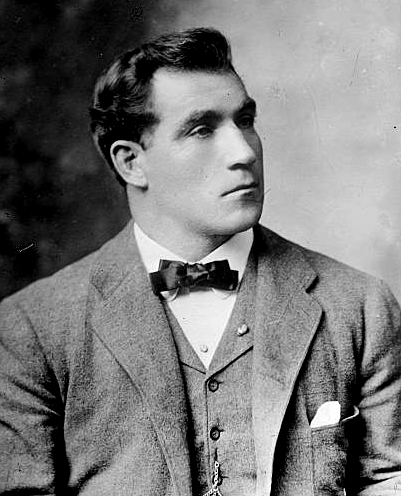 |
Tom
Sharkey was a crude brawler from the "Old School." At the sound of the
opening bell, he attacked, throwing bombs until the end. He was a rough
and durable violator of rules. To him, the rules were simply restrictions
that kept a real fight from taking place. |
|
He grabbed the elusive Jim Corbett, wrestled
him to the floor and began to pummel him. He pinned Jim Jeffries' left
arm-under his own, causing Jeff's glove to come off and when the referee
stepped in to put it back on, Sharkey took a murderous swipe at big Jim.
He frequently pushed referees aside and occasionally hit at them. He
head-butted, hit on breaks, held and hit, hit after the bell and got away
with it. |
He
was short and squat with excessively broad shoulders and a huge, deep chest upon
which was tattooed a colorful star and sailing ship. His motto was "Don't Give
Up the Ship." He used a straight-up stance but at 5-9 he was still a low target.
His nose was crooked and his left ear was cauliflowered (a gift from Gus Ruhlin
in their 1900 bout). Face-to-face confrontations with several all-time greats
only worsened the condition of the ear. It is said his hands were strong enough
to bend silver dollars. In style, he was aggressive and ever striding forward
towards his man, throwing powerful haymakers.
Sharkey once said, "The bigger they were, the better I liked it. I knew I
could cut them down to my size" (see UP Release, April 17, 1953). In the
article, "I Fought the Best of Them" (1939 pp 29 30), he wrote, "I made them all
back away from me. I had to carry the fight to them, including Jeffries."
There is no doubt that Sharkey could hit. In an era of brute strength,
where the capability to take it was a must and knockouts were hard to score, Tom
scored 37 knockouts in 54 bouts (almost 70 percent).
|
The "Sailor" fought the best men of his time. Twice each he fought
Jim Jeffries, Bob Fitzsimmons, Jim Corbett, Peter Maher, and Joe Goddard.
He fought both Gus Ruhlin and Joe Choynski three times. He also met John
L. Sullivan and Jack Monroe. |
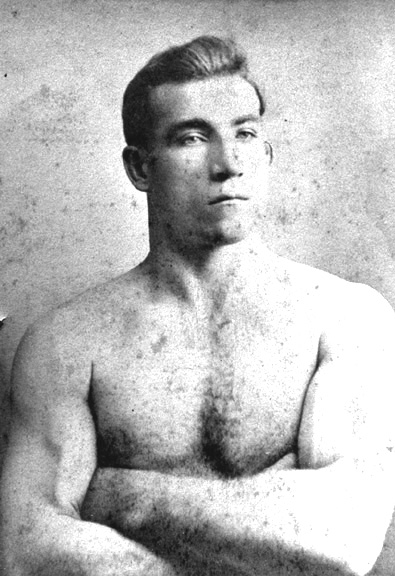 |
Boxing writers have long been in awe of the natural savagery and iron
will of Sharkey. One boxing historian described Sharkey as an "animal of a man
that swarmed all over his opponents." Hall-of-Fame writer Gilbert Odd called him
"a rugged fighter who depended more on toughness than skill." John J. Romano
(Everlast Boxing Record 1929 p 57) called Sharkey, "Game and aggressive to the
core." Stanley Weston described Sharkey as "one of the most durable heavyweights
of the olden era."
Diamond (1954 p 40) wrote that "Tom Sharkey was a veritable nightmare to
heavyweights. He never became champion, but with a little luck he might have
been ... He was very strong and muscular and had great power of endurance. He
would sail in like a whirlwind, let go with both arms - and keep on slugging.
His great weakness was that he couldn't block a punch and left himself wide
open." He observed: "Sharkey's punches, often wild and erratic, were always
dangerous."
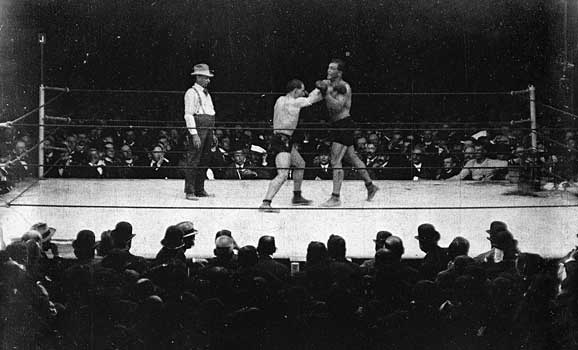 |
Durant-Bettmann (1952 p 120) said, "Sharkey was a tough, squat
battler who had the misfortune to appear when there were many great
heavyweights on the scene. He fought them all but could never quite win
the crown."
Willoughby (1970 p 360) writes, "One of the greatest of the
old-time 'near-champions' was the rugged sailor, Tom Sharkey, who fought
all the leading contenders of his day." Burrill (1974 p 175) writes
Sharkey was " regarded by some as an uncrowned champion."
|
Robert E. Howard, writer, boxing enthusiast, and creator of "Conan the
Barbarian" left an unfinished essay on the The Iron Man, "Sharkey was a
raw novice; Choynsky a trained veteran. Choynsky smashed Sharkey over the ropes
and out of the ring. The Sailor landed on his head on the concrete with all the
heft of his 190 pounds. That would have caved in most skulls like an eggshell.
Sharkey climbed back into the ring and knocked Choynsky out." According to
official records, there was no knockout.
Another historian,
John McCallum (1974 p 51) pictured "Sailor Tom" as "a rugged, sawed-off
Pier-Sixer with a brassbound sea chest of a torso and a rawhide constitution,
who gave Jeffries his hardest fights."
Jim Jeffries, himself, called Tom Sharkey his toughest opponent. In
his autobiography by Fullerton (1929 p VII), he twice put Sharkey's name in
capital letters. He called Sharkey the roughest, gamest, and most willing
fighter in the world (see Lardner 1972 p 131).
These two "Iron Men"
fought twice for a total of 45 rounds. The first bout lasted twenty rounds and
each man was "busted up." Following his close, disputed decision loss to
Jeffries in their first bout (1898), Sharkey vowed to defeat Jeffries in the
second bout or die trying. He almost died. His nose was broken, two ribs
cracked, his face cut up, and his left ear swollen to he size of a grapefruit.
The second fight, went 25 grueling rounds.
Promoter Bill Brady described
a little-known fact - Jeff's fight with Sharkey at the Coney Island place was
memorable not only for its own sake, but also because it was recorded in the
movies in the first film ever taken under artificial light. The story of how the
lights were so hot they burned both men bald-headed is well known. It isn't so
well known that the cameras broke down during the middle of the last round of
the fight and had to be taken over again some time later. Sharkey wanted to
"fight for real" but finally Brady convinced him to re-enact the last
round.
Indeed, this second fight (1899) is rated
among the all-time classics with both men dealing out and absorbing
considerable punishment, "a collision of natural strong
men."
Durant (1976 p 51) says that Sharkey was "... the rugged
sailor who might been champion in almost any other era of the ring."
|
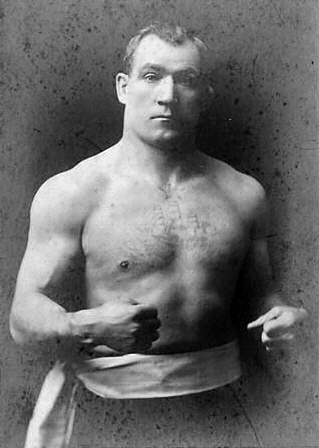 |
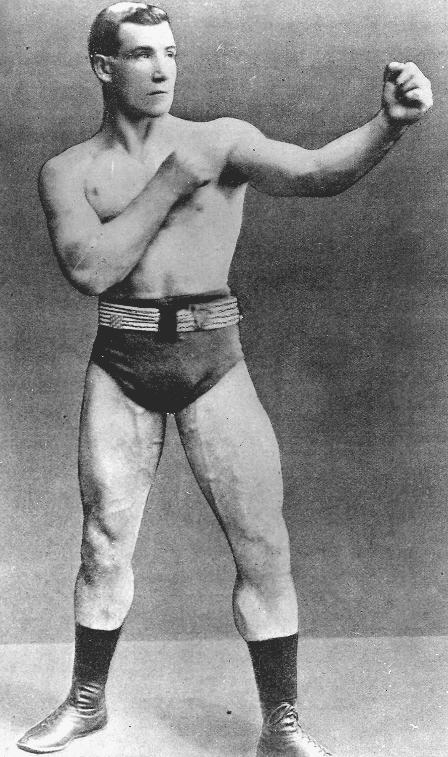 |
Charles Mathison, old time boxing man, was of the opinion that
"Sharkey was so rough and ready that Gene Tunney would have to be at his very
best to outpoint him."
TAD, boxing writer of the 1920s, wrote "Sharkey would raise Cain with
the boys of today. What a battle a Dempsey-Sharkey affair would have been."
Perhaps the most fitting legacy for the Sailor was given by his
namesake, Jack Sharkey, the Boston Gob. Shortly before his death, in an
interview with Mike DeLisa, the former Heavyweight Champion was shown a large
photo of Tom Sharkey. Jack looked at the picture, silent for a long while, then
said softly - "Now that was some fighter!"
It is the opinion
of this writer that Sharkey was a Rocky Marciano "look-a-like" and a
"near-equal"of the great "Rock" in ruggedness, power and size. He had the bad
luck to fight when Jim Jeffries, Bob Fitzsimmons, and Jim Corbett were around.
Had he fought in any other period of history, he probably would have been a
champion.
|
References
Bromberg, L.,
1958. World's Champs. Retail Distributors, Inc.
Diamond, W.,
1954. Kings Of The Ring. London: The World's Work (1913)
Ltd.
Durant, J. and
Bettman, O., 1952. Pictorial History Of American Sports. Cranbury, New
Jersey: A.S. Barnes and Co.
Durant, J.,
1976. The Heavyweight Champions. New York: Hastings House
Pub.
Fleischer, N.
and Andre, S., 1975. A Pictorial History Of Boxing. Secaucus, NJ: Castle
Books (an update of the 1959 book)
Fullerton, H.,
1929. Two-Fisted Jeff. Chicago: Consolidated Book Publishers,
Inc.
Howard, R.,
1976. The Iron Man. New York: Donald M. Grant,
Publisher
Lardner, R.,
1972. The Legendary Champions. New York: American Heritage
Press.
Litsky, F. 1975.
Superstars. Secaucus, New Jersey: Derbibooks, Inc.
McCallum, John,
1974. The World Heavyweight Boxing Championship. Radnor, Pa.: Chilton
Book Company
Odd, G., 1974.
Boxing: The Great Champions. London: The Hamlyn Publishing Group
Limited
Odd. G., 1976.
The Fighting Blacksmith. London: Pelham books, Ltd.
Romano, John J.,
1929. "The Navy In The Ring" (contained in the Everlast Boxing Record),
p. 57)
Sharkey, Tom,
1939. "I Fought The Best Of Them" (contained in Liberty magazine),
February 1939, pp 29-30.
Stockton, R.,
1977. Who Was The Greatest. Phoenix: Boxing
Enterprises.
Weston, Stanley,
1952. "Hit 'Em In The Slats Bob!" (contained in Boxing and Wrestling
magazine), pp. 20-23, 62-66.
Willoughby,
David, 1970. The Super Athletes. Cranbury, New Jersey: A.S. Barnes and
Co., Inc
Return to Top
Tom
Sharkey Record
Tracy Callis
All-Time Rankings
Callis Archive





